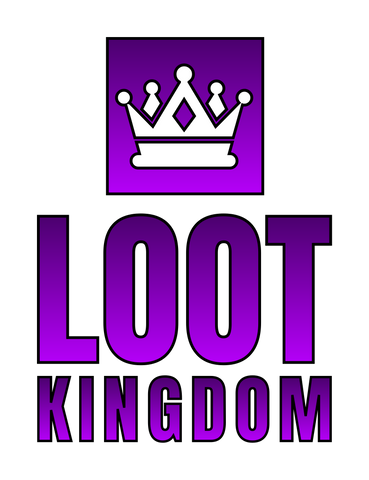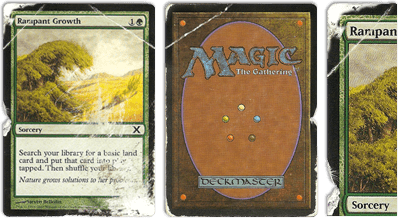Kyrptik Trading Card game brings horror-themed artwork, almost Diablo-esque artwork (Blizzard IP), to the TCG world. The game is simple and requires little to no dice or extra card accessories.
For this how-to-play article, I will go over the constructed main format.
Here are the quick start rules, reading a card and game zones provided by Kyrptik TCG to have an overview of the game.



How to win:
Each Player has 6 "11-year" cards. These 11-year cards act as shields or life; once you are out of 11-year cards and are attacked by a citizen, you lose the game. You also lose the game if you have no cards left in your deck.
How to set up:
Each Player gathers a minimum of 40 cards up to 60 cards with a sideboard of 15 cards. One deck can contain a maximum of three of the same card. Shuffle each deck and set aside six cards for your 11-year cards (your life) face down first, not looking at the cards. Then, set aside another six cards; this will be your hand where you play your spells and citizens (more on these terms later); you can look at these cards. You can change the cards from your hand by placing any number of cards on the bottom of your deck and drawing that many cards- this is called recursion and may be done only once at the beginning.
Who goes first?
Well, that will be up to you; rock, paper, scissors is always a good way to decide or flip a coin, but ultimately it is up to the players.
After the set-up:
It is time to play the game!
The order of phase for each turn is simple but essential.
A. Disengage
Before playing any card, you will need to "disengage "(by turning a Citizen card upright can be used to attack/block or used for their Citizen ability) cards that were "engaged" (when a Citizen card is turned sideways and cannot be used to attack or block unless otherwise stated) during the last turn. If this is the first turn, you can skip this step.
B. Draw
This phase is straightforward as you pick one card at the top of your deck into your hand. If you cannot draw, you lose. The player starting first cannot draw a card.
C. First Phase
The first actual phase is where you can play cards instead of disengaging and drawing.
You may do any of the following in no particular order:
- Play a card upside down in the soul row to use for a resource to play a Spell or Citizen. You can only play one card in your soul row per turn unless indicated by another effect from a card in play.
- Play a Citizen. Citizen cards generally stay on the "island" and can be used to attack your opponent's 11-year cards in an attempt to win the game. For a Citizen to be played, you must pay the appropriate soul cost for the citizen card. The number in the grey oval means you will need that number of soul cards in your soul row, which can be any colour. The remaining colour ovals must be adhered to play the Citizen. Some Citizen cards can only be played in this phase and will indicate in the textbox of the card.
- Spells are one-time actions (unless otherwise stated). Some Spell cards can only be played in this phase and will indicate in the textbox of the card.
A note, when playing Citizen cards, they may not attack the turn they are played (moved from hand to the "island") unless they have the keyword in the textbook "Eager." If a Citizen does not have the keyword "Eager," they are considered "Weary."
D. Combat Phase
This phase is straightforward. You pick a Citizen card and target an 11-year card (certain Citizen citizens can target two 11-year cards which will be indicated on the Citizen textbox with the keyword "Ravenous"). Then, the opposing Player can choose to let either:
- Let the attacking Citizen destroy the 11-year card.
- Block the attacking Citizen with one of their Citizens, in which case the attack and the defence of both Citizens do damage simultaneously.
For Citizens to damage each other matches the attack of one Citizen to the defence of the blocking Citizen and vice versa. If the attack does not meet or surpass the defence of the opposing Citizen, the Citizen lives and can survive another round. You can, however, use more than one Citizen to block an attacking Citizen and destroy the attacking Citizen. In those cases, the Citizens add their attack power together, and if the combined attack power meets or surpasses the defence of the opposing Citizen, they destroy the Citizen. The opposing Citizen being blocked by multiple Citizens can assign and divide the damage from their attack to each blocking Citizen and, if the attack surpasses or meets the defence, can destroy the Citizen. The damage taken from Citizen in combat remains until the end of the turn. When blocking with a Citizen, you will need to engage (turn sideways) to avoid blocking another Citizen.
The end of combat is also straightforward, as any effect that would happen triggers.
Remember that the Player that is attacking must choose one Citizen at a time and follow the steps below:
- The Player chooses Citizen to attack.
- The Player must pick a target(s) for the citizen (11-year card)
- The opposing Player can block (Citizens become engaged) or not.
- Assign any relevant damage and remove any Citizens if destroyed.
- Play out any effect at the end of combat.
- Repeat this process for each attacking Citizen.
E. Second Phase
This phase is like the First phase; you can play Spells or Citizens or play a card into your soul row if you have not already.
F. End turn
This phase is straightforward, you end your turn, and any effects or abilities that trigger at the "end of turn" will do so.
During turn one, the Player that goes first cannot draw.
Other terms that need to be defined are:
Abolished: A special zone where, at this moment, citizens cannot return
Limbo pile: Where discard cards and Citizen cards go once
And those are the basics for getting started with Kyrptik.
If you want to dive deeper, I will link the more comprehensive rules below.
https://docs.google.com/document/d/1er74dy1hjmw2vDkQ7Sb9n7GvM5s3doCAK29_86cObUw/mobilebasic
*All references and images that were used belong to their respective IP holders and are used under fair use law.*


 '
' '
' '
' '
' '
'